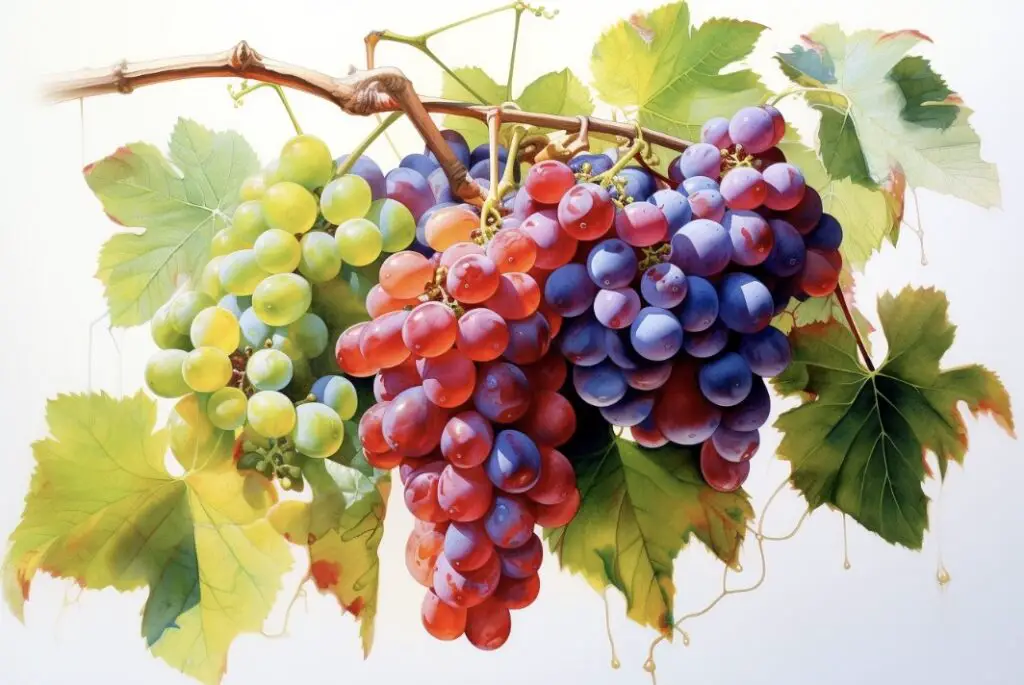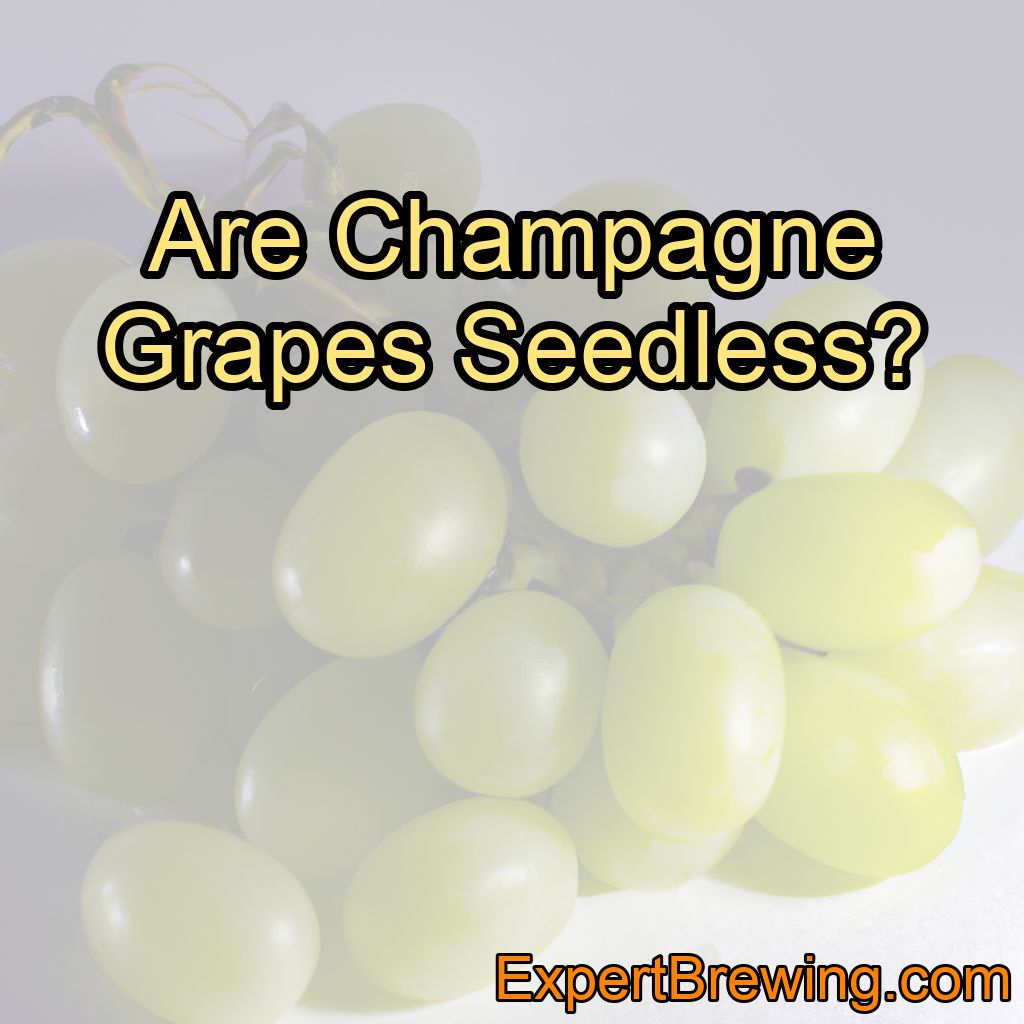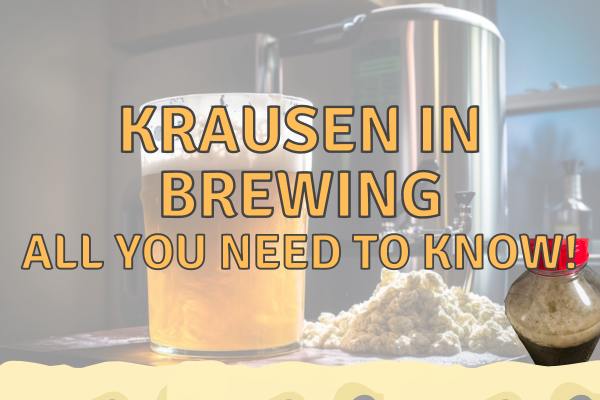The world of wine and champagne is fascinating and complex, with various grape varieties and production methods contributing to the vast array of flavors and styles.
One question that often arises is whether the grapes used to make champagne are seedless. In this blog post, we will delve into this topic, exploring the grape varieties used in champagne production, the reasons for using seeded or seedless grapes, and more.
So, are champagne grapes seedless? The answer is no. The grapes used in champagne production are not seedless, but the seeds are removed during the winemaking process.
The Grapes of Champagne
Champagne is a sparkling wine made from three primary grape varieties: Chardonnay, Pinot Noir, and Pinot Meunier. These grapes are grown in the Champagne region of France, which has a unique climate and soil composition that imparts distinct characteristics to the grapes and the wines they produce.

Chardonnay
Chardonnay is a white grape variety that is known for its versatility and ability to adapt to different climates and soils.
In the Champagne region, Chardonnay grapes produce wines with high acidity and a distinct minerality, contributing to the freshness and elegance of the resulting champagne.
Pinot Noir
Pinot Noir is a red grape variety, but it is also used in the production of Champagne.
The skins of Pinot Noir grapes are dark, but the juice is colorless, making it suitable for white sparkling wine production.
Pinot Noir grapes add structure, body, and complexity to Champagne blends.
They contribute flavors of red fruits, such as cherry and strawberry, as well as earthy and spicy notes. Pinot Noir-based Champagnes often exhibit richness, depth, and aging potential.
Pinot Meunier
Pinot Meunier is another red grape variety used in Champagne production. It is known for its good resistance to frost and diseases, making it an important grape for the region. Pinot Meunier grapes provide fruitiness, softness, and roundness to Champagne blends.
They bring flavors of ripe apples, pears, and sometimes floral or herbal notes. Pinot Meunier-based Champagnes tend to be approachable, fruit-forward, and can offer a youthful character.
Why Use Seeded Grapes?
There are several reasons why seeded grapes are used in the production of champagne, including flavor development, tannin extraction, and tradition.
Flavor Development
Seeded grapes, particularly those with thicker skins, are known for their ability to produce more complex and concentrated flavors than seedless varieties. This is due to the fact that the seeds contain various compounds, such as tannins and flavonoids, which contribute to the flavor and structure of the wine. By using seeded grapes, winemakers can create a more nuanced and sophisticated final product.

Tannin Extraction
Tannins are compounds found in grape seeds, skins, and stems that contribute to the mouthfeel, structure, and aging potential of a wine. In the production of champagne, the extraction of tannins from the grape seeds is an essential part of the winemaking process, as it helps to create a wine with the necessary body and complexity to withstand the secondary fermentation and aging that occurs in the bottle.
Tradition
The use of seeded grapes in champagne production is also a matter of tradition, as the grape varieties used to make champagne have been grown in the region for centuries. By using seeded grapes, winemakers are able to maintain a connection to the past and respect the history and culture of the Champagne region.
The Winemaking Process
In order to remove the seeds from the grapes, winemakers employ a process called pressing. After the grapes are harvested, they are brought to the winery and placed in a press, which gently squeezes the juice from the grapes while leaving the seeds, skins, and stems behind. This juice, known as the “must,” is then used to make the wine.
Pressing
There are various types of presses used in the production of champagne, but the most common is the traditional basket press. This press consists of a large, cylindrical basket made of wooden staves, with a heavy plate on top that is slowly lowered onto the grapes. The pressure exerted by the plate squeezes the juice from the grapes, with the seeds, skins, and stems remaining in the basket.
Fermentation
Once the must has been extracted, it is transferred to a fermentation vessel, usually made of stainless steel or oak. Here, yeast is added to the must, and the process of fermentation begins. During fermentation, the yeast consumes the sugar in the grape juice and converts it into alcohol and carbon dioxide. This process continues for several weeks, until all of the sugar has been consumed and the desired level of alcohol has been achieved.
Secondary Fermentation and Aging
After the primary fermentation is complete, the wine is bottled and sealed with a temporary cap. A small amount of sugar and yeast is added to each bottle, initiating a secondary fermentation. This fermentation process produces additional carbon dioxide, which becomes trapped in the bottle, creating the characteristic bubbles of champagne. The wine is then aged in the bottle for a minimum of 15 months for non-vintage champagne and three years for vintage champagne.
Seedless Grapes and Wine Production
While seedless grapes are not used in the production of champagne, they do have their place in the world of wine. Seedless grape varieties, such as Thompson Seedless and Flame Seedless, are often used to make table wines, as they can produce large quantities of fruit with a relatively low level of tannins.
These wines tend to be lighter in body and less complex than those made from seeded grapes and are generally best enjoyed young.
Conclusion
In conclusion, champagne grapes are not seedless. The grapes used in champagne production, Chardonnay, Pinot Noir, and Pinot Meunier, all contain seeds.
The seeds are removed during the winemaking process, and their presence contributes to the flavor development and tannin extraction that is essential for creating a high-quality champagne.
Here are 10 facts about champagne grapes and their role in the production of this iconic sparkling wine:
1. Champagne is made from three primary grape varieties: Chardonnay, Pinot Noir, and Pinot Meunier.
2. These grapes are grown exclusively in the Champagne region of France.
3. Seeded grapes are used in champagne production for their flavor development, tannin extraction, and traditional reasons.
4. The seeds are removed during the pressing process, which extracts the juice from the grapes.
5. Tannins from the grape seeds contribute to the body, structure, and aging potential of champagne.
6. The primary fermentation of champagne occurs in stainless steel or oak vessels, where yeast converts sugar into alcohol.
7. Secondary fermentation takes place in the bottle, creating the bubbles that are characteristic of champagne.
8. Non-vintage champagne is aged for a minimum of 15 months, while vintage champagne is aged for at least three years.
9. Seedless grape varieties are often used to make table wines, which are lighter in body and less complex than wines made from seeded grapes.
10. The Champagne region’s unique climate and soil composition contribute to the distinct characteristics of the grapes and the wines they produce.
FAQs
Why is it called Champagne grape?
The grape used to make Champagne is called Chardonnay, Pinot Noir, and Pinot Meunier, and it is called Champagne grape because it is primarily grown in the Champagne region of France, which is known for producing sparkling wine using this grape variety.
Do Champagne grapes contain alcohol?
Yes, Champagne grapes contain alcohol. They are used to make Champagne, which is a sparkling wine with an alcohol content typically ranging from 11% to 12.5%.
Do Champagne grapes taste good?
Yes, Champagne grapes are known for their sweet and intense flavor, making them a popular choice for snacking and dessert recipes.
Is grape champagne alcoholic?
Yes, grape champagne is alcoholic. Champagne is a type of sparkling wine that is made from grapes and undergoes a secondary fermentation process in the bottle, which produces carbon dioxide and alcohol. The alcohol content of champagne typically ranges from 11-12.5%.
What is a Champagne grape?
Champagne grapes are specific varieties of grapes, including Chardonnay, Pinot Noir, and Pinot Meunier, that are traditionally used to make Champagne, a sparkling wine produced in the Champagne region of France.
What do Champagne grapes taste like?
Champagne grapes, also known as Black Corinth grapes, are small and sweet with a slightly tart flavor. They have a unique floral aroma and are often used to make sweet wines, such as Muscat and Port.




